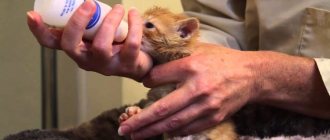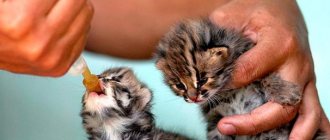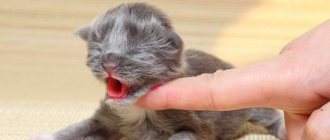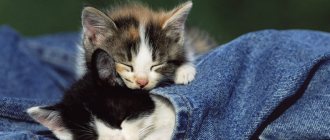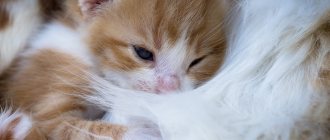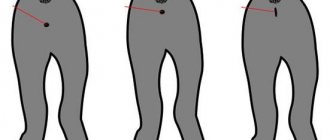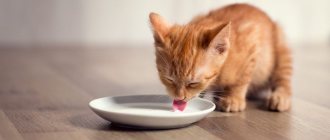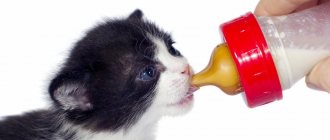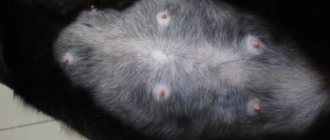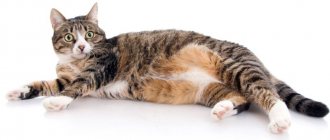Save the article:
feed a newborn kitten for various reasons. In any case, this is a serious responsibility for a small life.
The neonatal period for kittens ends at the age of two weeks. But these first two weeks of life play a decisive role not only in the future health of babies, but also for their very existence. During these two weeks, the kitten adapts to living outside the mother’s body, organs and systems continue to develop, breathing and circulatory processes normalize, the endocrine glands begin to work, changes in metabolism occur, and normal thermoregulation is established. And if during this period the owner is inattentive to the feeding procedure, then in addition to the development of diseases, this can lead to the death of the baby.
When do kittens need artificial feeding?
The ideal situation is as follows: the cat cares for and feeds the kitten until it is approximately 8 weeks old. Only then can you separate the baby from his mother. But there are times when human intervention and help is required. Reasons why this may happen include:
- death of a cat;
- lack or deficiency of milk in her;
- mastitis and inflammation of the uterus in a cat;
- eclampsia in a cat, that is, calcium deficiency;
- psycho-emotional deviations of the animal.
Sometimes the mother feeds the kittens regularly, but the babies still need complementary foods. This situation may arise if the litter is very large. It happens that a weak kitten is born, which quickly gets tired when sucking - in this case, it also needs additional nutrition. How you manage to feed a kitten without a cat or simply intervene a little in the process will determine its future health.
Reasons for abandoning offspring
Not every pet has such a strong maternal instinct as a cat. From the first minutes of the kittens' life, she fiercely protects and cares for her offspring.
A cat may refuse to feed newborn babies due to illness or stress. As felinologists note, a cat can leave the “nest” and abandon its offspring due to age, stress and other circumstances. It is important to understand that there is no such thing as a “bad cat mom.” If an animal refuses to feed kittens, you need to look for psychological or physiological reasons.
Non-viability of offspring
At an instinctive level, a cat detects a sick or hypothermic (low body temperature) kitten and refuses to nurse it. This kind of situation is often observed with a large litter: the female gives the right to life to stronger babies, feeling that there is not enough milk for everyone.
A weakened kitten is not always viable. A person can deliver such a baby by providing him with the correct temperature conditions, proper conditions of detention and feeding him with milk formulas.
Stress
Excessive fuss and attention of the owner to the process of delivery and newborn kittens can cause stress in the animal. As a result of accidental or intentional human intervention in the life of an animal, a cat may refuse to raise and feed its offspring.
Age
According to veterinarians, a cat that has not reached the age of puberty, but has already become a mother, does not want to nurse a litter. There is no need to rush and take the kittens from the “nest”. On the second day, the animal's maternal instinct may awaken.
The owner’s task is to provide the pet with complete rest and feed newborn babies with formula milk during the first day of life.
Lack of milk
One of the common reasons why a female abandons her offspring is the lack of milk due to hormonal imbalance as a result of premature birth. The cat began to give birth before the body had completely adjusted to a new way.
Foreign odors
A newborn kitten has the scent of its mother. If a person picks up a baby who has barely been born, he breaks the “baby-mother” connection. The animal may stop feeding the kitten, from which it does not catch its scent.
Weak maternal instinct
A pet spoiled by human attention does not feel responsible for its newborn offspring. A cat with a weak maternal instinct is not ready to breastfeed and care for her own offspring.
Feeding and caring for small blind kittens rests on the shoulders of humans.
Cat milk replacers
If the circumstances are not the best and the kitten is left without a mother, the ideal option would be to find a wet-nurse cat. If this is not possible, some alternative to cat milk will come to the rescue - its substitute. Feeding a newborn kitten is not as difficult as it seems at first glance.
Special mixtures from veterinary pharmacy
There are no organic substitutes for cat milk in nature. But today, some pet food manufacturers have created special mixtures - artificial substitutes for cat milk. They are as close as possible to the natural composition and are optimally balanced for kittens. The mixtures include many components useful for the growth and development of small pets:
- vitamins;
- minerals;
- microelements;
- Omega-3 and Omega-6 fatty acids;
- taurine
The veterinary formula is ideal for raising kittens until they are able to eat solid food on their own.
Recipes for DIY mixtures
If the price of a special mixture is too high or it is not sold in your locality, you can make it yourself - several recipes are offered.
Milk and flour
You will need 250 grams of condensed milk: always natural and twenty percent. You need to dilute it with a liter of water and add about a teaspoon of bone meal. Strain, heat and feed to babies. The mixture can be stored for no more than a day, so it is recommended to prepare it in smaller quantities. The main thing is to maintain the proportion 1:4.
With goat milk
A tablespoon of five percent glucose is mixed with goat milk, of which you will need about 1.5 tablespoons. Next, you need to add one gram of various vitamins (purchased at a veterinary pharmacy) and a teaspoon of milk powder.
Vitamin
Five percent glucose is mixed with one hundred milliliters of milk and an yolk mixed with half a tablespoon of vegetable oil is added. In the mixture you need to add Nutrilon milk baby food and a few drops of Tetravit.
Egg
A teaspoon of vegetable oil is mixed with the yolk and drops of vitamins in a proportion similar to the previous recipe.
Regardless of the composition, it is necessary to keep cat formulas in the refrigerator, and when serving, heat them to a temperature of 37 ° C. Veterinarians advise preparing complementary foods more often so that they are always fresh.
Why you shouldn't give cow's milk
When asked whether it is possible to feed a newborn kitten with cow's milk, veterinarians answer unequivocally in the negative. The composition of cat milk is very different from the milk of other animals - the amount of fat, protein and lactose varies greatly. Even adult cats do not digest goat's and cow's milk well, with their high content of lactose and fat, let alone kittens.
If you ignore the advice of veterinarians and scientifically proven facts, you can harm the baby’s health. Allergies, diarrhea, lack of essential nutrients, developmental delays - this is not a complete list of problems that can arise in a small animal when fed cow's milk. Take care of your baby's health and use special mixtures.
Feeding with ready-made formulas
global $ads_google;
//data-ad-slot=”2475549904″ $ads_google = empty($ads_google) ? false : true; ?> if ($ads_google == false) {?> $ads_google = true; ?> } ?> If you need to feed a kitten from its very birth, then you need to know what such babies are fed. Many people wonder whether it is possible to feed newborn kittens with infant formula or whether they will have to buy only specialized ready-made formulas.
If the situation is extreme, and there is baby formula in the house, then it can be diluted in a 1:2 ratio with water. Baby food formulas for the digestive system of kittens are too fatty and rich in micro- and macroelements. Diluted with water in the right proportion, they become less concentrated and heavy for the kitten’s stomach.
Cat milk substitutes have long been developed and sold in veterinary pharmacies. The milk of other animals is less suitable and can easily upset the animal's stomach.
Feeding formulas can be purchased in both liquid and powder form. The digestion of cat babies functions normally, the intestinal microflora is in perfect order.
How to feed a small kitten: features and rules
There are certain rules and nuances of feeding a kitten. This applies to both the feeding regimen and procedures after it.
What things will you need?
To feed a kitten, you will have to purchase some items. A bottle with a special nipple will be more convenient for you and better for the animal: such a thing is sold in a veterinary pharmacy. It has an anatomically correct shape and resembles a cat's nipples.
You can feed newborn kittens without a cat either with a pipette or with a syringe without a needle. But this option is undesirable, since during feeding, air may enter the esophagus or milk may enter the respiratory tract, causing the animal to choke or regurgitate. It is very important to wash and sterilize items after each feeding.
Stages of the procedure
When everything you need has been collected and sterilized, dilute the mixture according to the instructions and heat it. It is not recommended to do this in the microwave - the mixture may warm up unevenly - it is better to heat it in a water bath.
Check your pet's body temperature. If the paws are cold, the kitten is cold, which means the food will be digested much worse. The baby must be kept warm at all times. To do this, place a heating pad wrapped in a towel or a bottle of hot water in his box or house.
When you are sure that the kitten is warm, you can proceed directly to the feeding process. To do this, lay a towel on your knees, carefully lay the kitten on its stomach and lift its head a little - this is the position in which kittens feed from their mother. For the very first time, you should moisten the nipple's spout with milk so that the baby smells the food and begins to eat.
How to determine if a kitten is full
Both conditions are extremely undesirable and even dangerous for a baby: underfeeding and overfeeding. If he doesn't get enough food, he doesn't gain weight well and appears lethargic. Overeating is indicated by loose stools in yellow, green and gray shades. You can visually determine whether the kitten is full in the following way: extend your finger to it. If the animal begins to suck, then it is not full.
The baby’s behavior is also an indicator. If the kitten is full, he simply turns away and falls asleep, sometimes milk bubbles come out of his mouth, if not, he squeaks, crawls and looks for a pacifier.
What to do after feeding
During the process, try your best to ensure that the animals are calmed by your voice. Talk to them and be sure to pet them, and after feeding, wipe off any remaining food from their faces.
At the end of feeding, lightly press the kitten's back against your stomach and gently stroke its tummy. With these actions you stimulate belching and start the process of digesting food.
To prevent kittens from suffering from constipation, it is necessary to massage their anus. This is done with cotton pads or ear swabs, which are dipped in Vaseline.
Artificial stimulation of peristalsis does not always help, and babies experience stool retention. In this case, you need to give an enema, but it is better to do this under the supervision of a veterinarian - leave the procedure to him for the first time, later you will learn how to give enemas to kittens yourself.
How to care for a kitten and ensure its normal functioning without a cat
In addition to feeding, it is important for the kitten to equip the warmest place possible, where there are no drafts or dampness.
It is also necessary to wash kittens. Usually the mother cat does this, licking them regularly. To do this, the owner will need to moisten the cloth with warm water and gently wipe their face, tummy and fur. Such actions stimulate blood circulation and ensure proper psychological development of babies.
If any health problems arise, kittens should be taken to the veterinarian.
Video: how to care for a kitten on your own - advice from a veterinarian
Helping your kitten empty his bowels and bladder
Most of the systems and organs in kittens are imperfect, so they often experience constipation and problems with urination. Under natural conditions, a cat helps its offspring by carefully licking the kittens’ bellies, thereby stimulating the above-mentioned processes. The owner should massage these places with light movements, which is a simulation of the cat’s actions.
To do this, you can use a piece of clean, ironed soft cloth or a cotton pad. During the massage, it will be noticeable how the kitten performs the processes of defecation and urination. Perform a massage after every meal. If problems persist and massage is ineffective, you should immediately contact a veterinarian.
How often should you feed
It is imperative to follow the regime and monitor the portions of the mixture. For the first two weeks, you will have to feed the kitten every 2 hours, even at night. Then the intervals are gradually shortened. After five weeks, the kitten can easily survive without food for 3-4 hours, and at night one feeding is enough for him.
At 6 weeks of age, babies feed on their own: they need to be fed up to 5 times a day and only during the daytime. Kittens grow very quickly, so the nursing period will not seem very long.
When can a kitten be switched to self-feeding, at what age can a pet eat on its own?
From about one month of age, complementary foods should be introduced to the kitten, without stopping formula feeding. Baby purees containing meat ingredients are successfully used as complementary foods. It is not advisable to start feeding your baby meat or fish until he can digest such rough food.
After one and a half months, the kitten’s body is already ready to feed itself on “adult” food. Naturally, his diet should be as soft and gentle as possible.
Calculation of daily portions
In the natural environment, a cat does not control the amount of milk her kittens eat. But since the task is to feed a kitten without a cat, certain standards must be observed. The baby quickly gains weight, but his stomach volume is very small, so feeding should be dosed. The daily intake of the mixture depends on the age of the baby. Below is the amount calculated per 100 g of animal body weight:
- from birth to day 5 – 30 ml;
- from 6 to 14 days – 38 ml;
- from 15 to 24 days – 45 ml;
- from the 25th day and over the next month - 55 ml.
These are recommended figures and may vary slightly for each breed. The daily volume must be divided by the number of feedings. The most preferable option, as for humans, is in small portions, but more often.
Making your own kitten formulas
You can prepare milk formulas for small kittens aged 2 weeks to a month yourself using simple recipes:
- Tailing's mixture is nutritious and will be especially useful for exhausted, weakened, and poorly gaining weight babies. To prepare the mixture, add 5 g of milk powder, cat vitamins (1 g), and glucose (4 g) to 25 g of homemade milk. All ingredients are thoroughly mixed until smooth, without lumps, and heated over low heat to +38°C. The finished mixture is cooled to room temperature and used to feed artificial kittens through a pacifier or pipette.
- Scott's formula is a complete nutrition for kittens that can even replace mother's milk. To prepare this recipe, you need to combine the ingredients in one container: cow's milk (50 g), yeast (3 g), milk powder (15 g), sugar (5 g), sunflower oil (1 g), whipped egg white (50 g) , egg yolk (1). The mixture is whipped until smooth and heated to +37°C with constant stirring. The finished composition is poured into a bottle and cooled to room temperature. The mixture can be stored in the refrigerator, but no more than 1 day.
Difficulties and errors
The main and most serious mistake is a frivolous attitude towards what and in what quantities you feed the kitten. This can lead to serious problems with his health.
Pay attention to the position in which the baby eats. If you place it on its back, the mixture may enter the lungs while eating, and this often leads to death. It happens that milk comes out of the nose and the stomach swells greatly - this means that the baby has swallowed a lot of air and is trying to burp. During feeding, be sure to ensure the correct position.
If it is still acceptable to feed a kitten with a syringe at the initial stage, then experts do not recommend doing it from a spoon - such actions can lead to the fact that the sucking reflex disappears, and the baby will not be able to eat normally in the future.
Piece feeding
In principle, it is not difficult to feed a kitten that has lost its mother on your own. If you approach feeding correctly and follow the advice of more experienced specialists.
© shutterstock
First of all, you should remember that milk from a cow, based on the amount of certain components, is absolutely not suitable for feeding a kitten. So, if the level of water, lactose, fat and ash in cat and cow milk is almost the same, then if the protein in cat milk is 7.0, then in cow milk it is only 3.3%.
The best option for feeding a newborn kitten without a cat is to purchase a ready-made powder substitute. It could be :
- Royal Canin Baby Milk
- Kitty Milk
If you don’t have a veterinary pharmacy near you or don’t have enough money to buy one, you can prepare formula and feed newborn kittens yourself.
Caring for newborn and older kittens
To create comfortable conditions for furry babies, you need to take care of their place of residence. A large basin or cardboard box will serve as a “dwelling”, but you will have to constantly ensure that it does not get wet. For this purpose, absorbent material is purchased that absorbs excess moisture.
In the first days of life, kittens especially need warmth, so it is advisable to install a heater near their place of residence. If you don't have one, use a heating pad wrapped in a towel or a hot water bottle. Don’t forget: the minimum ambient temperature in the first two weeks of a baby’s life is kept at 30° C. After 14 days, lower the temperature to 24° and do not change it for another three weeks.
At three weeks of age, babies begin to try to walk: be careful that they do not fall out of their nest and get injured. The first walks should take place under your watchful supervision.
Try not to let kittens onto the carpet: they do not yet know how to retract their claws and therefore constantly cling. In worst cases, the baby may be injured.
At the fifth week of life, kittens see well and move actively. Then they are introduced to the first complementary foods. By 6 weeks of age they can eat solid food, and at 8-10 weeks they can be given to new owners.
To monitor the development of kittens, you will need an accurate scale. Weighing babies is necessary for:
- calculating the volume of daily portions;
- tracking growth rates.
If your kitten is not gaining weight well, you should consult your veterinarian. Perhaps the baby is malnourished or sick with something.
How to determine age, make a nest
The age of kittens is determined by several criteria:
- in the first three days a fresh umbilical cord is detected, later it falls off on its own;
- eyes open one and a half to two weeks after birth;
- the reaction to sounds appears from the fifth day, in addition, age can be calculated by the state of the ears - they are pressed to the surface of the head until the ear canal opens, then straightening occurs;
- by the third day of life, the baby weighs on average 100 g, after a week the weight gain is approximately 50 g, at the age of one month the baby’s body weight is 250 g;
- milk teeth appear in two-week-old kittens - the incisors grow first, then the fangs at the fourth week, all milk teeth appear by 4 months.
To create a cozy nest for kittens, you can use a small cardboard box. Since pets at an early age have a small body weight and an immature thermoregulation system, it is recommended to take care of heating.
For this purpose, use a heating pad and a cloth that is placed on the bottom of the box. Favorable temperature conditions range from 25 to 28-29 degrees.
The cat abandoned her kittens - what to do?
What to do if you are not ready to accept the death of kittens? There are several options to solve the problem.
The cat abandoned the kittens, what to do:
- The simplest and most profitable way is to find a nursing cat. Very often, cats add new babies to newborn kittens that their mother has abandoned. Oddly enough, cats usually never separate kittens and do not throw them out of the nest or box. Accordingly, they take care of them in the same way as their offspring.
- Where can you find a cat? There are many veterinary forums and animal shelters. This is where you can find a nursing cat. In this case, you will have to take her home with your offspring.
- This is the simplest option, because the cat requires not only milk, but also other skills and functions.
Kittens
Features of feeding by month
In the first month, the kittens' diet consists of dairy products, to which other foods are gradually added. In the second week, complementary foods in the form of meat broth begin to be introduced. As the kitten grows, it is fed minced poultry meat. It is also recommended to give various cereals and egg yolk.
From 1 month onwards, the diet includes more solid food - meat cut into small pieces, fruits and vegetables.
By 6 months you should stop drinking milk in its pure form. This is due to the fact that the kitten noticeably decreases the secretion of the enzyme lactase, which breaks down disaccharides, so diarrhea, vomiting and general malaise occur when using the product. Milk is replaced with fermented milk products - fermented baked milk, cottage cheese.
As you grow, other foods besides the mixture are included in the diet; nutrition can be:
- natural;
- ready;
- combined.
For kittens, both the regimen and the feeding process itself are important. Insufficient food can lead to exhaustion or impaired development of the pet. Failure to follow feeding rules leads to aspiration of the respiratory tract with food and other pathologies.
